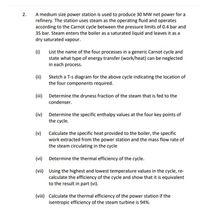
Elements Of Electromagnetics
7th Edition
ISBN: 9780190698614
Author: Sadiku, Matthew N. O.
Publisher: Oxford University Press
expand_more
expand_more
format_list_bulleted
Concept explainers
Question
Could subsection iv and onwards be solved please?

Transcribed Image Text:A medium size power station is used to produce 30 MW net power for a
refinery. The station uses steam as the operating fluid and operates
according to the Carnot cycle between the pressure limits of 0.4 bar and
35 bar. Steam enters the boiler as a saturated liquid and leaves it as a
dry saturated vapour.
2.
(i)
List the name of the four processes in a generic Carnot cycle and
state what type of energy transfer (work/heat) can be neglected
in each process.
(ii) Sketch a T-s diagram for the above cycle indicating the location of
the four components required.
(iii) Determine the dryness fraction of the steam that is fed to the
condenser.
(iv) Determine the specific enthalpy values at the four key points of
the cycle.
(v)
Calculate the specific heat provided to the boiler, the specific
work extracted from the power station and the mass flow rate of
the steam circulating in the cycle
(vi) Determine the thermal efficiency of the cycle.
(vii) Using the highest and lowest temperature values in the cycle, re-
calculate the efficiency of the cycle and show that it is equivalent
to the result in part (vi).
(viii) Calculate the thermal efficiency of the power station if the
isentropic efficiency of the steam turbine is 94%.

Transcribed Image Text:(ix)
State main disadvantages of using the Carnot cycle as the basis for
a power station.
(x)
State the name of the cycle that is used in practice in power
stations, along with three key benefits over the Carnot cycle.
Expert Solution
This question has been solved!
Explore an expertly crafted, step-by-step solution for a thorough understanding of key concepts.
Step by stepSolved in 6 steps with 6 images

Knowledge Booster
Learn more about
Need a deep-dive on the concept behind this application? Look no further. Learn more about this topic, mechanical-engineering and related others by exploring similar questions and additional content below.Similar questions
- I need problems 7, 8, and 9 answered pertaining to the print attached below.arrow_forwardThe answer is one of the options below please solve carefully and circle the correct option Please write clear .arrow_forwardI asked for problems 6 and 7 to be answered, but I did not get a properly structured answered as the example shows on problem number 1. Here is the link to the questions I already had answered, could you please rewrite the answer so its properly answered as the example shows (Problem 1)? https://www.bartleby.com/questions-and-answers/it-vivch-print-reading-for-industry-228-class-date-name-review-activity-112-for-each-local-note-or-c/cadc3f7b-2c2f-4471-842b-5a84bf505857arrow_forward
- Please answer part c and e onwards with working out and answer and please label the parts as you have answered a,b,darrow_forwardI am attaching both questions for 4 and 5 with the question in the image. thank you. NOTE : So the last person answered this question WITHOUT refencing the answer for whether question 4 or 5 answeres were given, so i am asking for question 5(or the answer for the question that was NOT solved because it was not referenced.) These were the following answers given to me from the last person on bartleby who answered my question without referencing whether it was the answer for question 4 or 5. 1 pass 2 fail 3 fail 4 passarrow_forwardHow would you solve this.arrow_forward
- Statics of Rigid Bodies Note: If you have already answered the problems in this post, kindly ignore it. If not, then answer it. Thank you, Tutor! Content Covered: - Method of Joints Direction: Create two problems based on the topic "Method of Joints" and then solve them with a complete solution. In return, I will give you a good rating. Thank you so much! Note: Please bear in mind to create two problems based on the topic "Method of Joints." Be careful with the calculations in the problem. Kindly double check the solution and answer if there is a deficiency. And also, box the final answer. Thank you so much!arrow_forwardI need parts 4, 5, and 6 answered pertaining to the print provided.arrow_forwardWhich of these expressions represents the value of G for a 90 degree elbow if the degree of fit is 45 degree, the radius of the welding elbow is 10 inches, and the outside diameter is 14 inches. A - 45x(10+7) B - 45x(10+14) C 45x(10x7)arrow_forward
- The answer is one of the options below please solve carefully and circle the correct option Please write clear .arrow_forwardPlease show work for all these answers and a clear and short explantion of each onearrow_forwardHow would you determine final dimensions using the plus & minus method for question #D??arrow_forward
arrow_back_ios
arrow_forward_ios
Recommended textbooks for you
 Elements Of ElectromagneticsMechanical EngineeringISBN:9780190698614Author:Sadiku, Matthew N. O.Publisher:Oxford University Press
Elements Of ElectromagneticsMechanical EngineeringISBN:9780190698614Author:Sadiku, Matthew N. O.Publisher:Oxford University Press Mechanics of Materials (10th Edition)Mechanical EngineeringISBN:9780134319650Author:Russell C. HibbelerPublisher:PEARSON
Mechanics of Materials (10th Edition)Mechanical EngineeringISBN:9780134319650Author:Russell C. HibbelerPublisher:PEARSON Thermodynamics: An Engineering ApproachMechanical EngineeringISBN:9781259822674Author:Yunus A. Cengel Dr., Michael A. BolesPublisher:McGraw-Hill Education
Thermodynamics: An Engineering ApproachMechanical EngineeringISBN:9781259822674Author:Yunus A. Cengel Dr., Michael A. BolesPublisher:McGraw-Hill Education Control Systems EngineeringMechanical EngineeringISBN:9781118170519Author:Norman S. NisePublisher:WILEY
Control Systems EngineeringMechanical EngineeringISBN:9781118170519Author:Norman S. NisePublisher:WILEY Mechanics of Materials (MindTap Course List)Mechanical EngineeringISBN:9781337093347Author:Barry J. Goodno, James M. GerePublisher:Cengage Learning
Mechanics of Materials (MindTap Course List)Mechanical EngineeringISBN:9781337093347Author:Barry J. Goodno, James M. GerePublisher:Cengage Learning Engineering Mechanics: StaticsMechanical EngineeringISBN:9781118807330Author:James L. Meriam, L. G. Kraige, J. N. BoltonPublisher:WILEY
Engineering Mechanics: StaticsMechanical EngineeringISBN:9781118807330Author:James L. Meriam, L. G. Kraige, J. N. BoltonPublisher:WILEY

Elements Of Electromagnetics
Mechanical Engineering
ISBN:9780190698614
Author:Sadiku, Matthew N. O.
Publisher:Oxford University Press

Mechanics of Materials (10th Edition)
Mechanical Engineering
ISBN:9780134319650
Author:Russell C. Hibbeler
Publisher:PEARSON

Thermodynamics: An Engineering Approach
Mechanical Engineering
ISBN:9781259822674
Author:Yunus A. Cengel Dr., Michael A. Boles
Publisher:McGraw-Hill Education

Control Systems Engineering
Mechanical Engineering
ISBN:9781118170519
Author:Norman S. Nise
Publisher:WILEY

Mechanics of Materials (MindTap Course List)
Mechanical Engineering
ISBN:9781337093347
Author:Barry J. Goodno, James M. Gere
Publisher:Cengage Learning

Engineering Mechanics: Statics
Mechanical Engineering
ISBN:9781118807330
Author:James L. Meriam, L. G. Kraige, J. N. Bolton
Publisher:WILEY